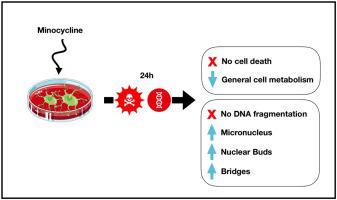Biomedicine & Pharmacotherapy ( IF 7.5 ) Pub Date : 2020-05-30 , DOI: 10.1016/j.biopha.2020.110285 Bruna Puty 1 , Iago César da Costa Nogueira 2 , Lygia S Nogueira 1 , Carolina Pinheiro Vasconcelos 2 , Teka Mayara Corrêa Araújo 1 , Leonardo Oliveira Bittencourt 1 , Railson de Oliveira Ferreira 1 , Edivaldo Herculano C de Oliveira 2 , Walace Gomes Leal 3 , Rafael Rodrigues Lima 1

|
Minocycline has been proposed as a neuroprotective agent with pleiotropic effects on several experimental models of neurodegenerative diseases, including microglial inhibition. However, although most studies have focused on the central actions of minocycline in affecting microglial functions, other central nervous system (CNS) cell types may also be affected by this drug toxicity. Hence, considering that glial cells play a pivotal role on CNS physiology and are the main responsible for neuronal integrity, a comprehensive investigation on the effects of minocycline treatment on human glial cells is mandatory before translational studies to afford neuroprotection in humans. Therefore, we explored the cytotoxic and genotoxic effects of minocycline at different concentrations in glial cells using an in vitro model. To achieve this, U87 glial cell were exposed to 10–50 μg/mL for 24 h. After exposure, cell viability, general metabolic status and genotoxic assays were performed. No changes were observed in cell viability, however, the general metabolic status decreased over 20 μg/mL. In addition, although no chromossome aberrations were observed, evidences of genotoxicity, such as increase on micronucleus, buds and bridges, were observed from 10 μg/mL. These results suggest that minocycline may induce genotoxic effects even at concentrations considered previously safe and should be used with caution in translational studies.
中文翻译:

非致命浓度的米诺环素在人神经胶质细胞培养物中的遗传毒性作用。
已提议米诺环素作为对多种神经退行性疾病实验模型具有多效作用的神经保护剂,包括小胶质细胞抑制。但是,尽管大多数研究都集中于美满霉素对小胶质细胞功能的影响,但其他中枢神经系统(CNS)细胞类型也可能受到这种药物毒性的影响。因此,考虑到神经胶质细胞在中枢神经系统生理中起着关键作用,并且是神经元完整性的主要负责者,因此在进行转化研究以提供人类神经保护之前,必须对米诺环素治疗对人类神经胶质细胞的影响进行全面研究。因此,我们使用体外模型探索了不同浓度的米诺环素在神经胶质细胞中的细胞毒性和遗传毒性作用。为了达成这个,将U87胶质细胞暴露于10–50μg/ mL的环境24小时。暴露后,进行细胞生存力,总体代谢状态和遗传毒性测定。没有观察到细胞活力的变化,但是,一般的代谢状态在超过20μg/ mL时下降。此外,尽管未观察到染色体畸变,但从10μg/ mL观察到了遗传毒性的证据,例如微核,芽和桥的增加。这些结果表明,即使在以前认为安全的浓度下,米诺环素也可能引起遗传毒性作用,在翻译研究中应谨慎使用。尽管未观察到染色体畸变,但从10μg/ mL观察到了遗传毒性的证据,例如微核,芽和桥的增加。这些结果表明,即使在以前认为安全的浓度下,米诺环素也可能引起遗传毒性作用,在翻译研究中应谨慎使用。尽管未观察到染色体畸变,但从10μg/ mL观察到了遗传毒性的证据,例如微核,芽和桥的增加。这些结果表明,即使在以前认为安全的浓度下,米诺环素也可能引起遗传毒性作用,在翻译研究中应谨慎使用。


























 京公网安备 11010802027423号
京公网安备 11010802027423号